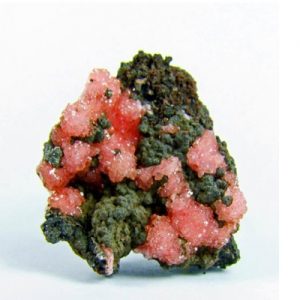Leucophoenicite
Leucophanite is a very rare beryllium silicate that was first discovered in the mines of Langesundsfjord district of Norway, a classic mineral locality filled with rare minerals. It is a member of the Fresnoite Group of minerals. Leucophanite may fluoresce pink or violet-blue in SW and LW UV and is strongly phosphorescent. It is also pyroelectric, meaning it has the ability to generate an electrical potential when heated or cooled.Leucophoenicite is generally brown, light purple-red, pink or raspberry-red in color; in thin section, it really is rose-red to colorless. The name hails from the Greek words leukos, meaning “pale”, and foinis, meaning “purple-red”, in the mention of its common coloring. Leucophoenicite typically occurs as isolated grains or this has granular habit this is certainly massive. Crystals regarding the mineral, which occurs rarely, are slender, prismatic, elongated, and striated.
The mineral forms in a reduced pressure, hydrothermal environment or perhaps in a contact zone when you look at the veins and skarns of a stratiform ore body this is certainly Zn-Mn. Leucophoenicite is a part regarding the group this is certainly humite. It was present in association with barite, barysilite, calcite, copper, franklinite, garnet, glaucochroite, hausmannite, jerrygibbsite, manganosite, pyrochroite, rhodochrosite, sonolite, spessartine, sussexite, tephroite, vesuvianite, willemite, and zincite. The four main locations for finding Leucophanite are the Langesundsfjord and other locations in Norway; in Russia at the Lovozero massif, Kola Peninsula; from Narssârssuk, Greenland; and at Mont Saint-Hilaire, Quebec, Canada where some of the best specimens are found.
| Category : | Nesosilicates |
| Chemical Formula: | Mn2+7(SiO4)3(OH)2 |
| Manganese Silicate Hydroxide | |
| Molecular Weight: | 694.83 gm |
| Composition: | Manganese | 55.35 % | Mn | 71.47 % | MnO |
| Silicon | 12.13 % | Si | 25.94 % | SiO2 | |
| Hydrogen | 0.29 % | H | 2.59 % | H2O | |
| Oxygen | 32.24 % | O | |||
| 100.00 % | 100.00 % | = TOTAL OXIDE |
| Crystallography: | Monoclinic – Prismatic |
| Crystal Habit: | Crystals rare, typically slender, prismatic, elongated and striated || [010], to 8 mm; in isolated grains or granular massive. |
| Twinning: | On {001}, common, contact or interpenetrant twins, lamellar. |
| Cleavage: | Imperfect on {001} |
| Fracture: | Irregular/uneven |
| Tenacity: | Brittle |
| Moh’s Hardness: | 5.5 – 6.0 |
| Density: | 3.848 (g/cm3) |
| Luminescence: | None |
| Radioactivity: | Not Radioactive |
| Color: | Brown to light purple-red, raspberry-red, deep pink to light pink; rose-red to colorless in thin section |
| Transparency: | Transparent to translucent |
| Luster: | Vitreous |
| Refractive Index: | 1.751 – 1.782 Biaxial ( – ) |
| Birefringence: | 0.031 |
| Dispersion: | Slight; r > v |
| Pleochroism: | Faint; rose-red parallel to {001}; colorless perpendicular to {001} |


